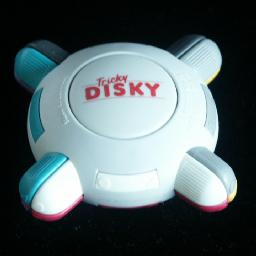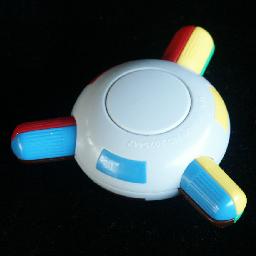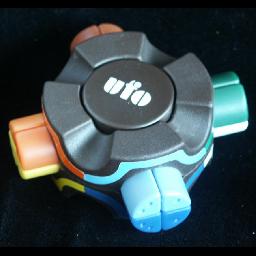





This is a disk made of two layers which can rotate with respect to each other. On the edge there are 4 groups of 4 coloured pieces. Each group is arranged in a circle with two pieces in the top layer, two in the bottom. When the top layer is rotated, the top two pieces of each group are carried along with it to the next group. Each group can be twisted, cyclically permuting its pieces.
The pieces come in 8 colours, so there are two pieces of each. The pieces are also marked with either a little triangle or a circle, so that all of the 16 are unique. The puzzle can be solved completely, with all 16 pieces in their correct positions, or you could solve the colours only and ignore the triangle and circle markings.
The puzzle was patented by Universal Connections Steckverbindungen Vertriebs GmbH, 28 December 1989, DE 3,821,297. The name of the inventor is not listed. The Tricky Disky has also been sold under several other names (such as Mind Trapper, and Tricky Disk), due to a trademark dispute.
The original version of the puzzle was Hungarian, and called the Ufo or Varia-Disk. That had a slightly different colour scheme, and pieces marked with one or two dots. It turns much more smoothly than the Tricky Disky. I was invented by Imre Peredy, patented 31 March 1983, WO 83/01009.
There is also a version which has only 3 groups of 4 coloured pieces, all without markings. This seems to be a cheap imitation of the Tricky Disky puzzle, made by some manufacturer in the far East. Its official name is the generic sounding "Magic Ufo Puzzle", but I tend to call it "Triple Disky".
There are 16 pieces, giving a maximum of 16! positions. All these positions are attainable, so there are 16! = 20,922,789,888,000 positions, assuming that the relative position of the two layers is not considered important. If the markings are ignored, then there are 16!/28 = 81,729,648,000 positions.
The Triple Disky, which has 12 pieces and no markings, has 12!/26 = 7,484,400 positions. I have done a computer analysis of the Triple Disky in order to find God's Algorithm. The results are in the tables below. Analogous to the Rubik's cube, there are two ways to count the moves. The Face Turn Metric means that a turn of any group of 4 pieces by any amount is a single move. The "Quarter" Turn Metric means that only 90 degree turns are single moves. In either case, a turn of the top layer is also a single move. The table shows that the puzzle can always be solved in no more than 13 moves (9.9544 on average), or 15 quarter turns (11.005 on average).
| Face turn metric | ||||||||||||||||
|---|---|---|---|---|---|---|---|---|---|---|---|---|---|---|---|---|
| Q u a r t e r t u r n m e t r i c | 0 | 1 | 2 | 3 | 4 | 5 | 6 | 7 | 8 | 9 | 10 | 11 | 12 | 13 | Total | |
| 0 | 1 | 1 | ||||||||||||||
| 1 | 6 | 6 | ||||||||||||||
| 2 | 3 | 24 | 27 | |||||||||||||
| 3 | 18 | 104 | 122 | |||||||||||||
| 4 | 3 | 108 | 412 | 523 | ||||||||||||
| 5 | 30 | 562 | 1596 | 2188 | ||||||||||||
| 6 | 1 | 255 | 2634 | 6167 | 9057 | |||||||||||
| 7 | 38 | 1499 | 11998 | 22795 | 36330 | |||||||||||
| 8 | 342 | 7851 | 51128 | 80438 | 139759 | |||||||||||
| 9 | 30 | 2118 | 36908 | 201130 | 250357 | 490543 | ||||||||||
| 10 | 230 | 10756 | 148423 | 686502 | 579125 | 1425036 | ||||||||||
| 11 | 10 | 1110 | 36237 | 469160 | 1598487 | 629520 | 2734524 | |||||||||
| 12 | 20 | 2451 | 74600 | 764251 | 1281186 | 103914 | 2226422 | |||||||||
| 13 | 2 | 8 | 1560 | 46368 | 259276 | 103473 | 329 | 411016 | ||||||||
| 14 | 135 | 3171 | 5343 | 159 | 8808 | |||||||||||
| 15 | 25 | 13 | 38 | |||||||||||||
| Total | 1 | 9 | 45 | 243 | 1267 | 6101 | 28374 | 122719 | 468687 | 1482179 | 2988366 | 2173153 | 212755 | 501 | 7484400 | |
F : Clockwise quarter twist of the group at the front.
F' : Anti-clockwise quarter twist of the front group.
F2 : Half twist of the front group.
B B' B2 : As above, but pertaining to the back group, the group opposite the front.
T T' T2 : Turns of the top layer.
Phase 1: Solve 3 pairs of pieces in the top half.
Phase 2: Solve 3 pairs in the bottom half.
Phase 3: Solve the final group.
Phase 1: Solve 2 pairs of pieces in the top half.
Use the same method as phase 1 for the normal disky.
Phase 2: Solve 2 pairs in the bottom half.
Use the same method as phase 2 for the normal disky.
Phase 3: Solve the final group of pieces.